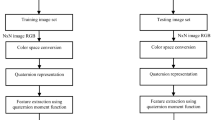Abstract
As a newly developed singular value decomposition of the reduced quaternion matrix (SVDRQ), the two reduced quaternion unitary matrices can effectively capture the intrinsic geometric structures and smooth contours of color texture image. The projection vector by the two unitary matrices is used as dominant features for color texture classification. In this paper, we proposed new algorithm to implement the computation of the SVDRQ, and then proposed new color texture classification scheme based on SVDRQ, the Euclidean distance is applied as classifier in the proposed scheme. It is demonstrated by the experiments that our proposed scheme significantly improves the color texture classification accuracy in comparison with several conventional texture classification approaches.






Similar content being viewed by others
References
Sertel O, Kong J, Catalyurek UV, Lozanski G (2009) Histopathological image analysis using model-based intermediate representations and color texture: follicular lymphoma grading. Signal Process 55(1–3):169–183
Maia E, Hammouch H, Aboutajdine A (August 2009) Color-texture analysis by mutual information for multispectral image classification. In: International conference on communications, computers and signal processing, Canada, pp 359–364
Martinez A, Delgado JL, Balibrea JD (2005) Automatic system for quality-based classification of marble textures. IEEE Trans Syst Man Cybern 35(4):488–497
Li Z, Liu Y, Walker R (2010) Color and texture feature fusion using kernel PCA with application to object-based vegetation species classification. IEEE Conf Image Process 8:2701–2704
Van de Wouwe G, Scheunders P, Livens S, Van Dyck D (1999) Wavelet correlation signatures for color texture characterization. Pattern Recogn 32(3):443–451
Selesnick IW, Baraniuk RG, Kingsbury RG (2005) The dual-tree complex wavelet transform. IEEE Trans Signal Process Mag 22(6):123–151
Ojala T, Pietikainen M, Maenpaa T (2002) Multiresolution gray-scale and rotation invariant texture classification with local binary patterns. IEEE Trans Pattern Anal Mach Intell 24(7):971–987
Palm C (2004) Color texture classification by integrative co-occurrence matrices. Pattern Recogn 37(5):965–976
Zhang C, Sun DW, Zheng L (2007) A new region-primitive method for classification of color meat image texture based size, orientation and contrast. Meat Sci 76(4):620–627
Dong YS, Ma JW (2011) Wavelet-based image texture classification using local energy histograms. IEEE Trans Signal Process Lett 18(4):247–250
Si ZZ, Zhu SC (2012) Learning hybrid image templates (HIT) by information projection. IEEE Trans Pattern Anal Mach Intell 34(7):1354–1367
Zhao CR, Liu CC, Lai ZH (2011) Multi-scale gist feature manifold for building recognition. Neurocomputing 74(17):2929–2940
Zhao CR, Lai ZH, Liu CC, Gu XJ, Qian JJ (2012) Fuzzy local maximal marginal embedding for feature extraction. Soft Comput 16(1):77–87
Zhao CR, Miao DQ, Lai ZH, Gao C, Liu CC, Yang JY (2013) Two-dimensional color uncorrelated discriminant analysis for face recognition. Neurocomputing 113(3):251–261
Lai ZH, Wan MH, Jin Z, Yang J (2011) Sparse two-dimensional local discriminant projections for feature extraction. Neurocomputing 74(4):629–637
Lai ZH, Zhao CR, Wan MH (2012) Fisher difference discriminant analysis: determining the effective discriminant subspace dimensions for face recognition. Neural Process Lett 35(3):203–220
Choi JY, Ro YM, Plataniotis KN (2012) Color local texture features for color face recognition. IEEE Trans Image Process 21(3):1366–1380
Hamilton WR (1866) Elements of quaternions. Longmans, Green and London
Daniel C, Weiss H, Bar IY (2012) Quaternion estimation from vector observations using a matrix Kalman filter. IEEE Trans Aerosp Electron Syst 48(4):3133–3158
Javier V, Palomar DP, Luis V, Ignacio S (2011) Quaternion ICA from second-order statistics. IEEE Trans Signal Process 59(4):1586–1600
Amir K, Pecht Y, Orly (2011) Quaternion structural similarity: a new quality index for color images. IEEE Trans Image Process 21(4):1526–1536
Bihan NL, Sangwine SJ (2007) Jacobi method for quaternion matrix singular value decomposition. Appl Math Comput 187(2):1265–1271
Wang QW, Li CK (2009) Ranks and the least-norm of the general solution to a system of quaternion matrix equations. Linear Algebra Appl 430(5–6):1626–1640
Sun YF, Chen SY, Yin B (2011) Color face recognition based on quaternion matrix representation. Pattern Recogn Lett 32(4):597–606
Bihan NL, Mars J (2004) Singular value decomposition of quaternion matrices: a new tool for vector-sensor signal processing. Signal Process 84(7):1177–1199
Menanno GM, Bihan NL (2010) Quaternion polynomial matrix diagonalization for the separation of polarized convolutive mixture. Signal Process 90(7):2219–2231
Wang QW, Yu SW, Lin CY (2008) Extreme ranks of a linear quaternion matrix expression subject to triple quaternion matrix equations with applications. Appl Math Comput 195(2):733–744
Database VisTex of color textures of MIT, USA. ftp://whitechape.media.mit.edu/pub/VisTex
Database of color textured barks of University of Koblenz Germany. ftp://ftphost.uni-koblenz.de/outgoing/vision/Lakmann/BarkTex
Lakmann R (1998) Statistische Modellierung von Farbtexturen, Ph.D. Thesis, University Koblenz-Landau, Folbach, Koblenz; in German
Acknowledgments
This work is partially supported by National Natural Science Foundation of China (61202319, 61272077, 61203243, 61162002); Department of Education of Jiangxi (GJJ13481); China Postdoctoral Science Foundation under Grant No. 2013M530224, 2013M530223. Open fund of Image Processing and Pattern Recognition under Grant No. TX201304001.
Author information
Authors and Affiliations
Corresponding author
Rights and permissions
About this article
Cite this article
Gai, S., Wan, M., Wang, L. et al. Reduced quaternion matrix for color texture classification. Neural Comput & Applic 25, 945–954 (2014). https://doi.org/10.1007/s00521-014-1578-0
Received:
Accepted:
Published:
Issue Date:
DOI: https://doi.org/10.1007/s00521-014-1578-0




